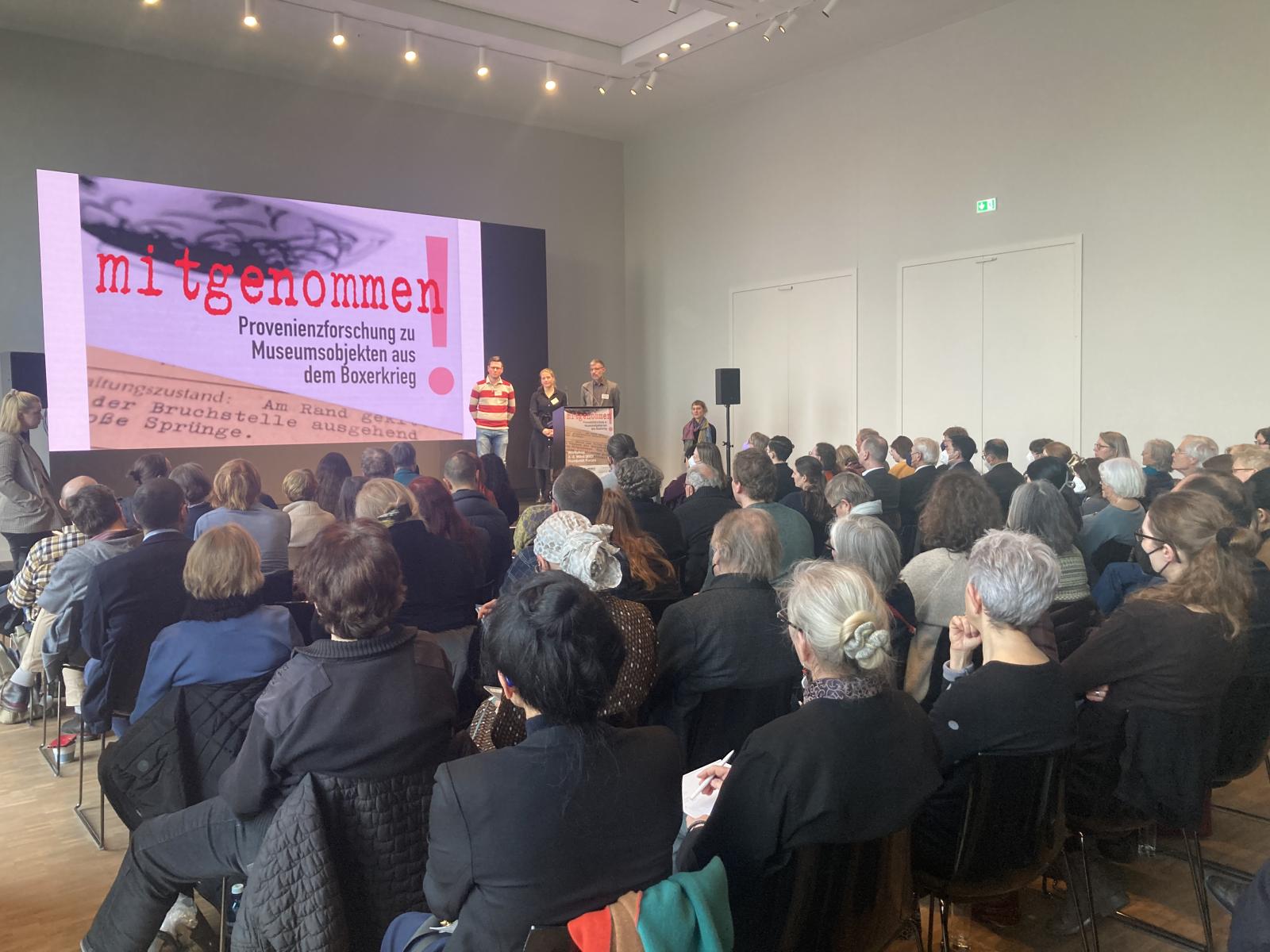Provenance research in colonial contexts creates uncertainty, posing questions that for a long time many people did not regard as questions. Uncertainty and how to confront it was the central theme of the workshop “Mitgenommen” held at the Humboldt Forum in Berlin on 2 and 3 March 2023, which was dedicated to items which changed hands during the Boxer War of 1900/01.
This event marked the halfway point of the project “Traces of the ‘Boxer War’ in German Museum Collections” funded by the German Lost Art Foundation, having been held just over a year after the project got underway. Seven museums are participating in this “joint approach”: the Museum of Asian Art and the Ethnological Museum (Berlin), the Museum für Kunst und Gewerbe and the Museum am Rothenbaum (Hamburg), the Grassi Museum of Applied Arts (Leipzig), the Five Continents Museum (Munich) and the Museum Angewandte Kunst (Frankfurt/Main). The project director is Christine Howald, provenance researcher and Deputy Director of the Central Archive of the National Museums in Berlin, while Kerstin Pannhorst takes care of coordination and research. Those missing from this long list were the cooperation partners from the Beijing Palace Museum, though Pannhorst did hold out the prospect of them being involved in a second workshop at the end of the year.
The aim of those up on stage on this occasion was to counteract the uncertainty, which begins with the fact that the Boxer War – i.e. the military intervention by eight colonial powers – was aimed at China, a country that does not seem like a victim at all from today’s perspective. In the summer of 1900, foreigners and Chinese Christians were threatened and killed by “Boxers” in Beijing and the surrounding area: depending on one’s point of view, the latter were either resistance fighters or simply impoverished peasants who, with good reason, blamed colonies such as nearby Qingdao, “punitive expeditions”, railway construction and Christian missions for their situation. Troops sent from the German Reich occupied and looted Beijing and the Forbidden City, among other places, and more than 100,000 people lost their lives. The imperial government was removed by a revolution ten years later, not least weakened by enormous “compensation payments”.
Who has any interest in the Boxer War now that more than 120 years have passed since it happened? Well, the queue of people waiting stretched right across the Schlüterhof courtyard of Berlin Palace. More than 150 people turned up – and they were not just regular museum-goers. The guests included all those in possession of Chinese objects that were created before 1900 and traded after 1900 – or brought over directly by a great-grandfather: Germany provided the largest number of troops, with a total of 20,000 soldiers, and very few of them will have returned without souvenirs. As Christine Howald emphasised, the project is not even able to investigate the provenance of all items in the participating museums. Instead, the aim is to trace patterns and compile a Provenance Research Manual for all those concerned.
The first day was dedicated to various aspects of the lootings. For example, Cord Eberspächer (Bonn/Changsha) explained which actors participated in or profited from the looting in Beijing, including both Chinese traders and Prussian museums. Ricarda Brosch (London) addressed the looting of the western imperial tombs of the Qing dynasty, specifically a handscroll. Maik Jachens (Hanover) talked about how he discovered looted goods at Landesmuseum Hanover, reported them to the Chinese embassy and made them the subject of a small exhibition. Finally, Bettina Zorn (Vienna), Susanne Knödel (Hamburg) and Birgitta Augustin (Berlin), all of whom are curators, showed examples of how the “Boxer War” provenance is dealt with in exhibitions today.
The second day was focused on the practice of provenance research – and demonstrated the sheer dimension of the problem. Presenters from six museums and the German National Library set out what they had identified as suspicious cases, with numbers varying from a handful to many thousands. This is not solely a problem of collection size, it also reveals a core problem: very few museums specialise in East Asia, and small institutions in particular are lacking in expertise. Nevertheless, many of them have objects from China in their holdings (though this is not always clearly recognisable) that were made before 1900 (ditto). If the museum archive does not provide any context either, the list of objects to be investigated can quickly mount up. Collections with a China focus may have a head start – but even their curators cannot simply identify looted items of property in passing.
For this reason, the organisers finished by collating the knowledge of all participants: what was special about this war, how can I identify suspicious items, what action do I then take, and where can I find information? The Provenance Research Manual that is to be produced will not replace the specially funded provenance research. But by listing relevant names of known places and collectors, for example, it can help private individuals, museums and also libraries to narrow down problem cases more effectively.
This will mean that the “universal suspicion” criticised by Renata Fu-sheng Franke can be dispelled more quickly or confirmed in individual cases (see the reply by Christine Howald). Other projects and exhibitions suggest that clear instances of looted goods tended to be the exception among merchandise and souvenirs from China. There is no reason to panic: demands for restitution are not known to have been made to date. But that should not be a reason for not wanting to know more. Looking more closely helps to deal with the uncertainty – and that is exactly what this workshop did.


